#televisual magic
Text
Magic, Myths, and Misfits: A Journey Through British Fantasy Television
Whether you’re a wizarding world devotee or a chronicler of Narnia, if you’re in the mood to mix a bit of televisual magic into your high fantasy diet, you’ve landed in the right place.
Here’s a list of ten British fantasy series that are as alluring as a freshly brewed cuppa.
Doctor Who
This one’s older than your granny’s favourite rocking chair. With a time-travelling alien who changes faces…
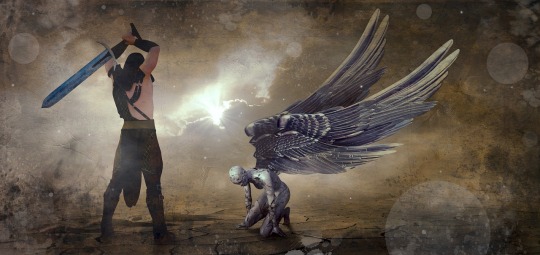
View On WordPress
#alternate realities#apocalypse#Arthurian legend#BAFTA-winning#Being Human#British fantasy TV#Doctor Who#Good Omens#high fantasy series#His Dark Materials#In The Flesh#Jonathan Strange & Mr Norrell#magical lands#Merlin#Misfits#Philip Pullman#supernatural shows#televisual magic#The Fades#The Worst Witch
2 notes
·
View notes
Text
Spooky season fairytales (2)
If there are two "Halloween fairytales" among the great and well-known classics, it would be "Hansel and Gretel" (see my previous post), and "Snow-White".
I have to admit that Snow-White has strong connotations with winter, and has been interpreted many times as a winter or spring tale (the spring interpretation being part of this wave of analysis which has every female fairytale protagonist saved from death or sleep be a symbol of spring - Sleeping Beauty, Little Red Riding Hood, and many more). But when you think about it, Snow-White is the perfect Halloween tale. It involves kind of "resurrecting" the dead. It involves a witch as an antagonist. It is centered around an apple, which is THE Halloween fruit. It relies on the use of disguises. It has a magical mirror - and Halloween was a night for divination by mirror and other mirror-rituals. EVERYTHING IS HERE!
And it also helps that surprisingly, it got the horror treatment many, many times. More than actual horrifying fairytales. But I'll blame this on the first movie in my "Spooky watch-list":
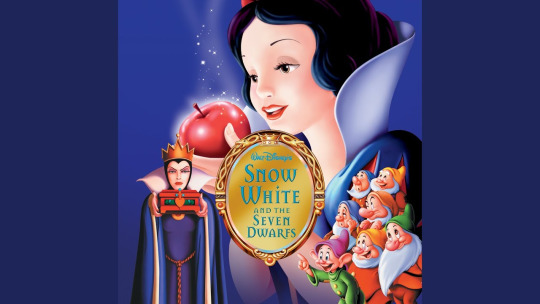
DISNEY'S SNOW WHITE!
Why is it on a list of creepy, dark and horror movies you ask? Because this movie, despite being incredibly sweet and a childhood classic, was also frigginly terrifying. It traumatized entire generations of children - kids had to be removed from theaters due to some of the creepy sequences. And still today horror pieces take inspiration from Disney's movie!
Three specific sequences form the "horror trio" of this movie. 1) The scene of Snow-White fleeing the hunter in the forest, and her terror-induced hallucinations which make the forest a place of horror. 2) The scene of the Witch-Queen going in her skeletons-flled dungeons, brewing deadly poisons, and ESPECIALLY the scene of her painful and frightening transformation into the old hag. The old hag herself is a terrifying visual which defined the image of a witch for most of the 20th century, and stayed a children's bogeywoman for generations. (By extension the Magic Mirror itself is a very creepy element of the movie, with its eeriness and uncanniness) 3) The sequence going from Snow-White's death to the death of the wicked queen. This climax of the movie is also yet another scene of great terror for any little kid.
Overall, it is ironic, but Disney's Snow-White stays one of the creepiest and more frightening faithful retellings of the Grimm fairytales - at least for a third of the movie. The rest is just wholeness cuteness and beautiful animation.

Of course, nowadays when you search for "dark fairytale movies", you will always end up hearing about 2012's "Snow-White and the Huntsman". One of the two Snow-White movies released on this year, alongside "Mirror Mirror" - and the two competing in very different lanes, since Mirror Mirror was a more light-hearted, humoristic, and "traditional fantasy" take on the fairytale, whereas "Snow-White and the Huntsman" was a "grimdark" take on the story, which marked the grimdark genre of the 2010s clearly embodied by the televisual success of "Game of Thrones".
I also like to draw a parallel between this movie and "Hansel and Gretel: Witch Hunters", which form the two "adult dark action-fantasy" fairytale movies of the 2010s. Not that they are identical, far from it - "Witch Hunters" is a fast-paced, video-game-like, "punch-em-all-kill-em-all-and-big-explosions-everywhere" type of "dark fantasy action movie", with a lot of humor (or of attempts at humor), while this movie truly goes for gritty fight scenes, vicious war depictions, and is dead-serious in its treatment of the story as a grand epic about survival in the wilds, the destruction of nature, evil sorcery and kingdom-destroying conflicts.
If you ask me, I understand why the reception of this movie was very divisive, and why it was a success despite everybody mocking it or hating it at the time of its release. This movie is a true "neutral" piece. It is an admirable movie - because it has absolutely stunning visuals, impressing special effects, and it is a gorgeous movies with some fascinating and clever ideas. It does take inspiration from the Disney movie "Snow White and the seven dwarfs", very clearly, but the way it twists these references into proper horror material or true dark fantasy matter (such as the "dark forest") is done very well. But it is also unfortunately a forgetable movie by many aspects. For example, I personally did not care about the two titular characters (Snow-White and the Huntsman) which did not felt like actual characters, but more like simple "plot-puppets", here to clearly fulfill a very archetypal and stereotyped fantasy plotline filled with rushed elements and extremely-thin character development. Hopefully not all the characters are bad - and in fact, beyond the stunning visuals, there is one character this movie should be seen for.
Ravenna, the evil queen. She is definitively one of the "best" part of this movie (though definitively one of the most evil and vile characters of fairytale movies) - everything about her from her concept (the queen of Snow-White turned fantasy evil overlord/inhuman witch-queen) to her crazy outfits passing by her impressive magic spells and the way her actress truly offers an intensely deranged embodiment of narcissistic evil... This is one of the more monstrous and frightening depictions of the evil queen I saw and I am all here for it. Two scenes in particular stand out for me: the poisoned apple scene (which is a true twist that does come off as very well executed) and the concept of the "magic" mirror and how it works.
Unfortunately, for an excellent half of the movie, there is another that is... at best average, at worst boring - hence the "neutral" of this movie. And of course, there is also the very awkward fact that instead of hiring dwarf actors for playing the dwarfs, they hired big-named actors of average height who were then "shrunk" by special effects... A very bad move that did not go unnoticed at the movie's release and does hit a bit more this very ambitious but ultimately half-working piece. Go watch it for Ravenna, for the Dark Forest, for the Sanctuary and the Magic Mirror and the poisoned apple scene... But the rest you can skip without losing much.

However, "Snow White and the Huntsman" was certainly not the first attempt at making Snow-White a dark and mature fantasy movie. Oh no! There was a predecessor long before it - a movie that should not be forgotten and did mark the history of Snow-White adaptations. I am talking of course of the 1997's "Snow White: A Tale of Terror", still coming at the top of "dark fairytale movie" lists.
This movie as to my knowledge the first real attempt at making a horror story out of Snow-White - in a time when making fairytales dark and "edgy" wasn't a common fashion. It also stood out for many different reasons - but it most notably stood out for its treatment of the "evil queen" character, Lady Claudia, played by none other than friggin' Sigourney Weaver herself! One has to watch the movie just to see Weaver's performance and appreciate the handling of the character of Claudia. This movie was one of the first ones who tried to depict the "wicked stepmother" of the tale as an actual human being, driven to evil rather than just evil from the beginning. Claudia is a woman who is seen falling into despair and madness as she is hit with all sorts of blights, ranging from things we can relate to (an impossible relationship between step-daughter and step-mother) to absolutely awful things - and this all serves to draw an explanation as to where her narcissistic vanity and where her hatred from Snow-White comes from, instead of just cartoonish petty jealousy. And once the human side of the character has been fully established, we delve into a terrifyingly inhuman one, as she becomes a dreadfully powerful wicked witch - to tell you the scope of this movie, the first two attempts at murdering Snow-White, the comb and the corset, were replaced here by Claudia summoning NATURAL DISASTERS.
Mind you this movie is far from being perfect - and while it is admirable in term of fairytale movies, it is definitively not working great as a movie simple. For the most part it works and is absolutely "gorgeous" (sometimes in the most repulsive ways): you have good acting, cool ideas and concepts, fascinating costumes and set pieces (the "magic mirror" is immensely cool), some good practical special effects, and very cunning use and display of character psychology and character growth (I especially appreciated the twist of Snow-White, here Lilly, trusting the obviously monstrous and frightening old woman, because she learned from experiences to not trust appearances and that ugliness doesn't mean evilness).
But all that being said, there's flaws. Already if you are an animal lover be careful: there are some visuals that can be harsh, and there are some animal stunts that seemed dangerously unsafe (I unfortunately could not find information on if animals were actually hurt). Outside of that, the climax of the story and grand final does seem a bit confusing and throw-around a bit, with some stuff coming out of nowhere, some things never explained (and not in the good "mysterious" way, in the "I want the visual and the idea but I don't know how to fit it in" kind of way), and there's some moments where you sense they truly wanted to go far with the shock value (*cough cough* the father tied to the upside-down cross* cough cough*). Plus there's the whole rushed relationship between Lilly (Snow White) and the outlaws (seven dwarfs - except here only one is a dwarf). You start with a point A (Lily is the terrified hostage of outlaws that are not pleasant nor kind) and you have a point C (Lily is now a good friend of the outlaws and admired by them, and even has a romantic tension with one of them - you can guess which, he's the one they purposefully made sexier than the other), but the point B about the development of such a character growth is missing.
Overall it feels that this movie was a project too ambitious for its means and for its time - but we won't hold a grudge towards it, because for its two thirds it stays a brilliant and truly strong piece of dark fairytale storytelling with excellent ideas (that were truly new and groundbreaking at the time of the movie's release), and while the last third is confused, rushed and incomplete, you still feel the heart and the intentions there.
However if I end up learning animals were actually hurt during the making of the movie, I'll really be pissed off (I am especially thinking about the horse stunts at the beginning, which didn't look really safe).
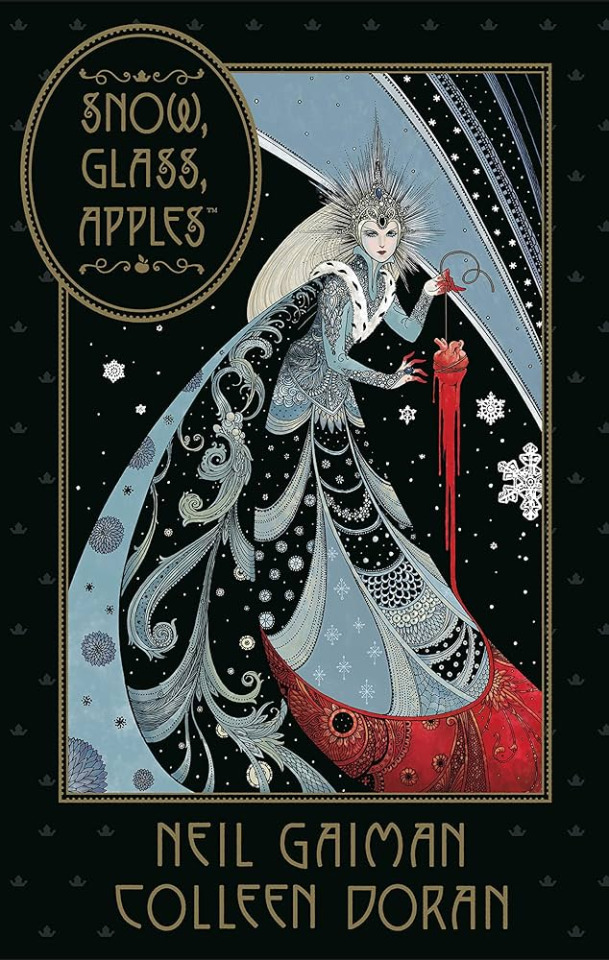
Not a movie, but to conclude this post I HAVE to mention Neil Gaiman's brilliant and disturbing shot story "Snow, Glass Apples". Released in 1994 - and it is no spoiler what the story is about now - it is not the first time someone reimagined Snow-White as a vampire (Tanith Lee did it before in her "Red as Blood" book), but it is certainly the most popular take on this idea and what in fact made this concept more well-known in popular culture.
Beware however - because this isn't just about Snow-White being a vampire, and the "stepmother" an actual benevolent queen and good witch, in a simple twist of the original tale. Oh no... It is a dark and depraved (in a good way) piece that depicts Snow-White as a old-fashioned vampire, in the style of the original Dracula and the folk monsters that came before him. We are talking of a frightening nightmare, of a village-decimating plague, of a repulsive undead succubus, of a blood-sucking beast in human shape...
One thing I do find fascinating with this story is that in its depraved elements, it ends up being an eerie echo to the first chapter of "Ludwig Revolution". Those that read the manga will know what I am talking about.
If you do not want to read the short story (despite it being actually available for public freely right here), there is a brilliant and gorgeous comic-book adaptation by Colleen Doran released in 2019. The beautiful, detailled, richly ornated, carefully-crafted art of Doran serves to better highlight the Gothic morbidity and the repulsive folklore behind this tragic and poetically bleak retelling, by adding fairytale colors to the nightmare, and freezing the horror in a stained glass.
#spooky season fairytales#spooky season#dark fairytales#horror fairytales#snow white#fairytale movies#horror movies#neil gaiman#snow glass apples#a tale of terror#snow white and the huntsman#disney's snow white
22 notes
·
View notes
Note
15, 16 & 30 😘
15. do you feel like there are any overrated TV show formats?
Not really, in that the word overrated always makes me feel like an obnoxious hipster judging people for liking something popular, and that's not really the vibe I'm aiming for in life.
That being said, I have a lot of ethical concerns with reality TV shows that make people without media training look like assholes on international TV and then send them back to their lives without properly supporting them. I wouldn't say that any particular reality format is overrated, but I really wish there was less production of reality TV shows until industries and audiences learned how to appropriately respond to and handle the real people whose lives are impacted by being on TV.
16. do you feel like there are any underrated TV show formats?
I don't know if underrated is the right word for this, but I feel like the multicamera sitcom is underappreciated as a televisual format. There's something about the way it translated a theatrical performance style to television to make use of live broadcasting that's kind of magical to me, and it's sad to me that the format has been delegitimized and associated mostly with cringey humor and laugh tracks.
... that being said, there are very few new multicam sitcoms that I enjoy because I find the humor cringey and I really dislike the ones that use laugh tracks, so I'm on the wrong side of my own argument, whoops.
30. what’s one show you could probably write a 2,000 word essay on, and what would be your topic?
Me, a media studies PhD student nervously eyeing my 80k+ thesis: welllll
Normally I'd say Buffy, but the thing I've been thinking about tonight is JatP and the way that people in fandom (particularly adults) were so quick to dismiss the label of children's show because they felt that that label 1) had a negative connotation, and 2) was at odds with the nuanced depiction of things like grief. I always get annoyed by the way people insist that a show is no longer a children's show if they think it's good, and then they complain that the remaining things they'll acknowledge as children's media are bad.
So a 2k rant about how JatP's use of tropes from children's media enabled it to tell a nuanced and powerful story about grief, because this scholar is fueled by spite.
TV ask game!
7 notes
·
View notes
Text
Apocalypse Now makes Vietnam irreal, because the intelligibility to experience it is missing. The derealising of real world event is an implicit theme of the film. Willard’s eyes are constantly shown registering disbelief that the events he witnesses are reality, but then he has shattered the mirror and crossed over into mythology. Apocalypse Now is Cambodia after the rain, through which Willard (you) is lured, dragged, drawn, called towards Kurtz, who is waiting, killing constantly without judgment, without morality, gazing back into the eye of the surreal maelstrom which is becoming Willard-shaped.
No heroic gestures, no klaxons blare, no alarms ring as Kurtz reaches out to flex his fingers in the stuff that is Willard; but surely, as he must, Willard comes. Somewhere else Apocalypse Now shifts into being war as Videodrome. War becomes cinematographic, televisual, hallucinogenic, surreal; just pure images coded into a fantastic psychedelic-technological semiotic, a hyperreality of surfaces. Here is a war — call it a film — where psychics predict enemy movement, combat drugs are distributed to induce psychotic-berserker visionary states, and experimental accumicon-visored helmets use bio-tech micro-circuits to enhance vision into multiple dimensions. Vietnam 1965 and El Salvador 1995 are interchangeable. War is idiot-servant machine intelligence observing itself. The treatment of Vietnam through Apocalypse Now ensures that war as hysterical violence-cum-insensate savagery becomes film, and film as fascination with this annihilatory vortex becomes war as semiotic. The two superimpose, intermesh, double, exchange genetic codings, united by their mutual overflows of technologies and bodies.
Apocalypse Now is conceived as a world historical event for which Vietnam is only a pretext, a superficial topography. Coppola reaches below the surface into a furious underworld and wakes up the beast. The beast wakes, gazes out through Kurtz’s eyes, smiles like an angel at the knowledge of being the worst thing in the world, then strikes — reaches out and takes this cyber-baroque dream of napalming the tropics, swallows it and recodes the film as a power already filming itself as it unfolds. Power — Apocalypse Now as the anticipation of reality by images, the procession of images and media in relation to events, such that the connection between cause and effect becomes scrambled and it becomes impossible to tell which is the effect of the other. Apocalypse Now is a war, a power, a magical operation of immense proportions, on which the movements of the planes, helicopters and troops are inscribing a mystical sign on the surface of reality, Willard’s retina, in which to survive, you — call yourself Willard — have to figure out your location and move accordingly.
— Mark Downham, Stoke Newington after the Rain: Representation and Difference in ‘Apocalypse Now’, in Vague 20: Televisionaries (1988)
4 notes
·
View notes
Text
††BLACK MASS @ PANDEMONIO†† 08.13.2023
Rasputina - If Your Kisses Can’t Hold Hold The Man You Love
Nachtmahr - Tanzdiktator
Agonoize - Koprolalie
Suicide Commando - Conspiracy With the Devil
Evil’s Toy - Organics (Slow Motion Mix)
FGFC820 - The Heart of America
Dismantled - Get It Through
Apoptygma Berzerk - Kathy’s Song (Ferry Corsten’s Mix)
Bruderschaft - Forever (Grendel EssenZ Remix)
Revolting Cocks - Attack Ships on Fire
Ministry - So What
KMFDM - Juke Joint Jezebel
MSI - Girls On Film
Voltaire - Magic Dance
Grace Overthrown - Fight
Front Line Assembly - Rock Me Amadeus
NIN - Closer
Night Club - Candy Coated Suicide
Glaring - Paralyzed
The Cure - Fascination Street
Peter Murphy - Deep Ocean, Vast Sea
The Sisters of Mercy - First and Last and Always
Gary Numan - My Name Is Ruin
Faderhead - Move Harder
Skinny Puppy - Worlock(ed)
Wumpscut - Wreath of Barbs
Suicide Commando - Comatose Delusion (Overdose V3.0 Mix)
MCL - New York
Nitzer Ebb - Join In The Chant
Front 242 - Welcome To Paradise
Bow Wow Wow - I Want Candy (Razed In Black Mix)
Apoptygma Berzerk - Backdraft (Sarpsborg Synth Version)
Velvet Acid Christ - Lysergia
Revolting Cocks - Do Ya Think I’m Sexy?
Das Ich - Kreig Im Paradies
KMFDM - Liquor Fish & Cigarettes
Night Club - Show It To Me
HEALTH - Cyberpunk 2.0.2.0
Ulver - Machine Guns & Peacock Feathers
Depeche Mode - Never Let Me Down Again
Siouxsie and the Banshees - Peek-A-Boo
Christian Death - Deathwish
Alien Sex Fiend - Ignore the Machine (Electrode Mix)
Joy Division - A Means To An End
Virgin Prunes - Pagan Love Song
Sisters of Mercy - Alice
The Cure - Lovesong
Faith & The Muse - Battle Hymn
Front Line Assembly - Killing Grounds
NIN - Sin
Godhead - Bela Lugosi’s Dead
Celldweller - Blackstar (Sebastian Komor Remix)
Powerman 5000 - Black Lipstick
Zeromancer - Dr Online (Rico Remix)
Imperative Reaction - Minus All
Project Pitchfork - Timekiller
Psyclon Nine - Divine Infekt
Suicide Commando - Hellraiser (Psychopath 01 Version)
Apoptygma Berzerk - Deep Red
VNV Nation - Chrome
La Scaltra - Nightmares
Actors - Face Meets Glass
She Past Away - Ritüel
She Wants Revenge - Red Flags & Long Nights
Christian Death - Spiritual Cramp (Creux Lies Remix)
Apoptygma Berzerk - Major Tom (Coming Home) [Technomancer Remix)
Juno Reactor - Conga Fury
Ministry - NWO
KMFDM - These Boots Are Made For Walkin’
Laibach - Opus Dei
Siouxsie & The Banshees - Night Shift
London After Midnight - Kiss
TNV - Televisual
HEALTH - Feel Nothing
3TEETH - Pearls 2 Swine
Haujobb - Speed of Pain
Ayria - Blue Alice (Dead When I Found Her Mix)
Corlyx - My Body Is Wrong
Rob Zombie - Pussy Liquor (Ki:Theory Remix)
0 notes
Text
So I was telling one of the 17 year olds we have working as a waitress about this guest who was in a foul mood and he pressed the button for the lift and two seconds later he snaps at me "so where is it??!?!" and that I felt like saying to him "you do have to wait it doesn't magically appear in front of you like the Tardis" and she says:
"What's the Tardis?"
And I felt my entire soul leave my body.
Do you know nothing about your televisual culture child?!
13 notes
·
View notes
Text
Press/Gallery: How Elizabeth Olsen Brought Marvel From Mainstream to Prestige
“The thing I love about being an actor is to fully work with someone and try so hard to be at every level with them, chasing whatever it is you need or want from them.”
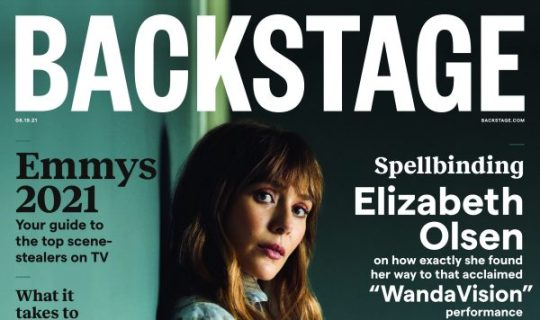

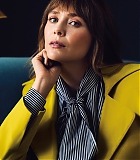

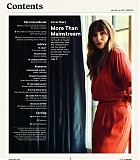
GALLERY LINKS
Studio Photoshoots > 2021 > Session 008
Magazine Scans > 2021 > Backstage (August 19)
Backstage: Elizabeth Olsen grins widely over video chat when recalling many such moments on set with her co-stars. Yet, she can’t bring herself to divorce such a lofty vision of film acting from the technical multitasking it requires. The camera sees all.
“But then you move your hair, and you’re in your brain, like: OK, remember that! Because I don’t want to edit myself out of a shot. I know some actors are like, ‘Continuity, shmontinuity!’ But the good thing about continuity is, if you remember it, you’re actually providing yourself with more options for the edit.”
That need to balance being both inside the scene and outside of it, fully living it and yet constantly visualizing it on a screen, feels particularly apt in light of Olsen’s most recent project, “WandaVision.”
The mysteries at the heart of the show grow with every episode, each fast-forwarding to a different decade: Could this 1950s, black-and-white, “filmed in front of a studio audience” newlyweds bit be a grief-stricken dream? Might this ’70s spoof be a powerful spell gone awry? Could this meta take on mockumentary comedies be proof that the multiverse is finally coming to the Marvel Cinematic Universe?
The series’ structure, which branches out to include government agents intent on finding out why Westview has seemingly disappeared, calls for the entire cast to play with a mix of genres, balancing a shape-shifting tone that culminates in an epic, MCU-style conclusion. What’s key—and why the show struck a chord with audiences during its nine-episode run—is the miniseries’ commitment to grounding its initial kooky setups and its later special effects-driven spectacle in heartbreaking emotional truths. It’s no small feat, though it’s one that can often be taken for granted.
“I was thinking how hard it would have been to have shot the first ‘Lord of the Rings,’ ” Olsen muses. “Like, you’re putting all these actors [into the frame] later and at all these different levels. All the eyelines are completely unnatural. And yet the performances are fantastic! And technically, they are so hard. People forget sometimes that these things are really technically hard to shoot. And if you are moved by their performance, that took a lot of multitasking.”
As someone who has learned plenty about harnesses, wirework, fight choreography, and green screens (she’s starred in four Marvel movies, including the box office megahit “Avengers: Endgame,” after all), Olsen knows how hard it can be to wrap one’s brain around the work needed to pull off those big, splashy scenes.
“If you think about it, it’s, like, the biggest stakes in the entire world—every time. And that feels silly to act over and over again, especially when people are in silly costumes and the love of your life is purple and sparkly, and every time you kiss them, you have to worry about getting it on your hands. Those things are ridiculous. You feel ridiculous. So there is a part of your brain that has to shovel that away and just look into someone’s eyeballs—and sometimes, they don’t even have eyeballs!”
The ability to spend so much time with Wanda, albeit in the guise of sitcom parodies, was a welcome opportunity for Olsen. Not only did it allow the actor to really wrestle with the traumatic backstory that has long defined the character in the MCU, but having the chance to calibrate a performance that functions on so many different levels was a thrilling challenge.
“It was such an amazing work experience,” she says. “Kathryn [Hahn] uses the word ‘profound’—which is so sweet, because it is Marvel, and people, you know, don’t think of those experiences as profound when they watch them. But it really was such a special crew that [director] Matt Shakman and [creator] Jac Schaeffer created. It was a really healthy working environment.”
Related‘WandaVision’ Star Kathryn Hahn’s Secret to Building a Scene-Stealing Performance
‘WandaVision’ Star Kathryn Hahn’s Secret to Building a Scene-Stealing Performance
Considering that the miniseries spans several sitcom iterations, various layers of televisual reality, and a number of character reveals that needed to feel truthful and impactful in equal measure, Shakman’s decision to work closely with his actors ahead of shooting was key.
“We truly had a gorgeous amount of time together before we started filming,” Olsen remembers. “Our goal was—which is controversial in TV land—that if you wanted to change [anything], like dialogue in a scene, you had to give those notes a week before we even got there. Because sometimes you get to set, and someone had a brilliant idea while they were sleeping, and you’re like, ‘We don’t have an hour to talk about this. We have seven pages to shoot.’ And so, we were all on the same page with one another, knowing what we were shooting ahead of time.
“Matt just treated us like a troupe of actors who were about to do some regional theater shit,” she adds with a smile.
That spirit of camaraderie was, not coincidentally, at the heart of Olsen’s breakout project, Sean Durkin’s 2011 indie sensation “Martha Marcy May Marlene.” As an introduction to the process of filmmaking to a young stage-trained actor, Durkin’s quietly devastating drama was a dream—and an invaluable learning opportunity.
“It was truly just a bunch of people who loved the script, who just were doing the work. I didn’t understand lenses, so I just did the same thing all the time. I never knew if the camera would be on me or not. There was just so much purity in that experience, and you only have that once.”
The film announced Olsen as a talent to watch: a keen-eyed performer capable of deploying a stilted physicality and clipped delivery, which she used to conjure up a wounded girl learning how to shake off her time spent in a cult in upstate New York. But Olsen admits that it took her a while to figure out how to navigate her career choices afterward. In the years following “Martha,” she felt compelled to try on everything: a horror flick here, a high-profile remake there, a period piece here, an action movie there. It wasn’t until she starred in neo-Western thriller “Wind River” (alongside fellow Marvel regular Jeremy Renner) and the dark comedy “Ingrid Goes West” (opposite a deliciously deranged Aubrey Plaza) that Olsen found her groove.
“It was at that point, when I was five years into working, where I was like, Ah, I know how I want it. I know what I need from these people—from who’s involved, from producers, from directors, from the character, from the script—in order to trust that it’s going to be a fruitful experience.”
As Olsen looks back on her first decade as a working actor, she points out how far removed she is from that young girl who broke out in “Martha Marcy May Marlene.”
“I feel like a totally different person. I don’t know if everyone who’s in their early 30s feels like their early 20s self is a totally different human. But when I think about that version of myself, it feels like a long time ago; there’s a lot learned in a decade.”
Those early years were marked by a self-effacing humility that often led Olsen to defer to others when it came to key decisions about the characters she was playing. But she now feels emboldened to not only stand up for herself and her choices but for others on her sets as well.
“[Facebook Watch series] ‘Sorry for Your Loss’ I got to produce, and I really found my voice in a collaborative leadership way. And with ‘WandaVision,’ Paul [Bettany] and I really took on that feeling, as well—especially since we were introducing new characters to Marvel and wanted [those actors] to feel protected and helped,” she says. “They could ask questions and make sure they felt like they had all the things they needed because sometimes you don’t even know what you need to ask.”
It’s a lesson she learned working with filmmaker Marc Abraham on the Hank Williams biopic “I Saw the Light,” and she’s carried it with her ever since. “I really want it to feel like we’re all in this together, as a team,” Olsen says. “That was part of ‘Sorry for Your Loss’ and it was part of ‘WandaVision,’ and I hope to continue that kind of energy because those have been some of the healthiest work experiences I’ve had.”
If Olsen sounds particularly zealous about the importance of a comfortable, working set, it is because she’s well aware that therein lies an integral part of the work and the process. As an actor, she wants to feel protected and nurtured by those around her, whether she’s reacting to a telling, quiet line of dialogue about grief or donning her iconic Scarlet Witch outfit during a magic-filled mid-air action sequence.
“Sometimes you’re going to be foolish, you know? And [you need to] feel brave to be foolish. Sometimes people feel embarrassed on set and snap. But if you’re in a place where people feel like they’re allowed to be an idiot,” she says, “you’re going to feel better about being an idiot.”
This story originally appeared in the Aug. 19 issue of Backstage Magazine. Subscribe here.
Press/Gallery: How Elizabeth Olsen Brought Marvel From Mainstream to Prestige was originally published on Elizabeth Olsen Source • Your source for everything Elizabeth Olsen
#Elizabeth Olsen#WandaVision#Avengers#Scarlet Witch#Wanda Maximoff#Sorry For Your Loss#Avengers Infinity War#Avengers Age of Ultron#Captain America Civil War#Ingrid Goes West#Godzilla#Doctor Strange in the Multiverse of Madness#Marvel#MCU#Candy Montgomery#Love and Death#Avengers Endgame
48 notes
·
View notes
Text
Round-Up Review: WandaVision (Spoilers)

Spoiler Warning: I am posting this review the Monday after the finale of WandaVision drops on Disney+, so if you haven’t yet seen the entire series don’t read on until you have.
So I was going to do a fully fleshed out review of the entire series of WandaVision, but just as I’m about to finish…Tumblr decides to freeze on me and I lose a day of work so I have now decided to work this review a different way and rather than giving a general reaction and going into a character analysis, I will be breaking it down into what I loved, what wasn’t there for me fully and where I feel we are going next.
General Reaction:
So I could of very easily gone through this series episode by episode...but based on the fact that not only was this a play-by-play mystery with a lot more questions than answers each week, but also as the series progressed, particularly after Evan Peters arrived at the end of episode 5, the fan-theories and potential spoilers almost made me not want to know what was going to happen because the theories were becoming so grand that the series could surely never live up to expectations, which is why I feel the director of the finalé stated that fans may be disappointed...because ultimately I don’t think the finalé did live up to expectations. But these were expectations built up as an culmination of fan-theories, comic-book insight and also MCU baiting.

By MCU baiting, I mean that the creatives of WandaVision decided to be creative, and possibly playful, by including several red herrings that went absolutely nowhere but were the main conspiracy theories driving the fan-speculations and fake spoilers throughout the latter half of the series.

Dottie...who was she? Nobody important. Evan Peters...was he Quicksilver? No. Was he Mephisto/Nightmare? No. Was he important? Not really. Monica’s mysterious engineer contact, a fan-favourite character? Not even a character from the comics, I think.

Now that’s not to say this series asked questions that weren’t answered satisfactorily, but a lot of them seemed to build up to what is to come rather than giving us all the answers in this series. Is that a good thing? Yes because I feel this will make this series more rewatchable than I feel it already is. I for one of re-watched each episode at least twice sometimes three times each week leading up to the next episode and having just seen the entire series as a whole product I can safely say that characters and elements from this series going forward may have call-backs to the events of this series which will make for clicks, more views and more plays.

Speaking of watchability, can we talk about how interesting it has been to watch half-hour scheduled programming for 9 weeks like the olden days, and the fact we can call television life before streaming “the olden days”?.

But honestly sitting down, for me on a Friday morning at 9:30am without fail, to watch what began as a 25–30-minute MCU sitcom before turning into a 30–40-minute MCU mystery every week harkened back to my childhood and coming back from school to watch my shows which only aired once a week at that time. Feige’s and the creatives in the MCU brought back that feeling of nostalgia for me which I never really expected from a comic-book property.
Speaking of classic televisual viewing, I really enjoyed the standard sitcom setup of this series. I knew of all the referenced shows going in like The Dick Van Dyke Show, Bewitched, The Brady Bunch, Malcolm in the Middle and Modern Family, but it was also nice to see some standard sitcom tropes seen in the majority of sitcoms utilized throughout. From Agatha posing as the nosey neighbour to the fashions of each sitcom era and even the fourth wall breaks both from Billy in the Halloween episode in a Malcolm in the Middle spoof to the following episode literally titled “Breaking the Fourth Wall”.
Also, I will say here that all those MCU “stans” who are complaining they didn’t get the big grand beginning of Phase 4 that was promised to us by Feige as “something different”, the guy’s mantra is to keep it simple and the finalé was hardcore Feige. “Something different” was the set up and delivery of this slice of the MCU and some fans are still moaning about that so some people are just never satisfied.
What I Loved
Scarlet Witch

Give Elizabeth Olsen awards for this season! Make gold rain down upon her! Honestly, I have loved Elizabeth Olsen as Wanda Maximoff since her formal introduction in Avengers: Age of Ultron, but now we have formally been introduced to the Scarlet Witch she is not only the most powerful female if not character in the MCU but also the best character in the entire MCU to date.
Not only is this series personifying how an individual deals with their grief, but when you consider the fact that Wanda, who is by all accounts a 29 year old woman due to being blipped for 5 years, and has lost her parents at a young age, her twin brother at 25-26 so still a young age and then the first love of her life twice, first by her own hand and then by the Mad Titan so that initial sacrifice was for nothing, it’s just a lot to put on one individual with this level of raw power without expecting her to finally snap and create an alternate reality where everything is under her control.
The creation of her twins, who I will get into further down, was well done and, for want of a better word, organic for the series. But I did like how they showed the real-life struggle of not just having a new-born but having twins. Wanda is trying to maintain control of this world she has created as well as keep Vision in check, but also because the twins are seemingly not under her magical control, she must juggle maintaining the world and its people with being a new mother.

But the biggest crisis for Wanda comes in when Fietro shows up, I still do not believe she ever truly thought this was her dead brother resurrected. It wasn’t until he said “long lost brother” that he asked “Pietro?” and she spent the entire next episode interrogating him until the façade finally slipped and she decided he wasn’t.

After this, everything falls apart for her. Not only is her reality literally slipping with Vision at odds with her, the world constantly shifting between eras and her not understanding what is happening.
This is of course when she is confronted by Agatha Harkness who has not only taken her twins but also been fooling her by being “Nosy Neighbour Auntie Agnes” for this entire time when in reality she is a with from the days of the Salem Witch Trials who wants to understand Wanda’s true potential and then absorb all of her magic.

But when we got to see Wanda’s true potential as she went “Beast Mode” as the Scarlet Witch complete with stunning new outfit and crown, this levels the character up to that top spot in the MCU as the best and most powerful character.
I am excited to see where the Scarlet Witch’s potential will take her next.
WandaVision Love Story

I also really loved the fact that as well as a personification of dealing with Wanda’s grief, this series was truly a love story between Wanda and Vision.
From the first episode when we see them getting “married” and being that unusual suburban couple trying to fit in with seemingly everyday suburban life when the entire set-up is Wanda’s idyllic dream world.
As Darcy said to Vision, the love these two have is real. I did an entire post on why Scarlet Witch and Vision are the best MCU couple, and this series amplifies that. It becomes clear that these two are not actually married and in fact this Vision isn’t even the Vision we have seen developed through the movies, but he is a replication of Wanda’s true love and this is how she chooses to show it.
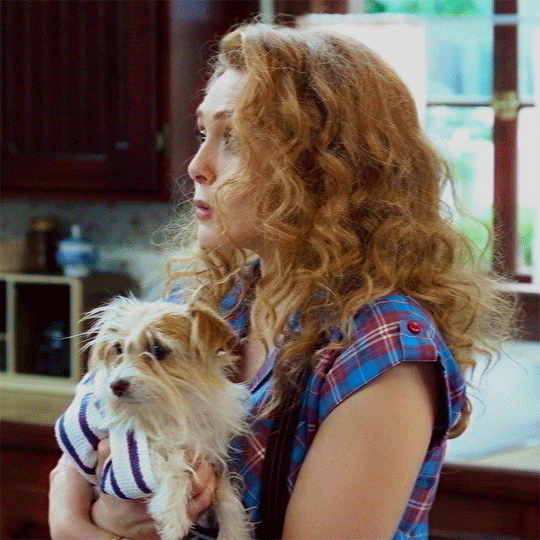
The fact they go through all of the typical newlywed couple goalposts of marriage, homemakers, kids, a dog, domestic disputes. It’s all there and feels so natural even though we are talking about the relationship a potential Nexus Being and a Synthezoid.

Their final goodbye in the series finale is honestly as heart-breaking as any love-lost in a tragic romance movie. Seriously how many more times is Wanda, and by extension the fans, supposed to say goodbye to Vision?
Agatha Harkness

I love Kathryn Hahn, this series has solidified that for me. Not only is this the first live-action appearance of Agatha Harkness but also the way in which she was modified from the comics is in a way that I would be annoyed with any other way if not for the fact that it was Kathryn Hahn playing her.
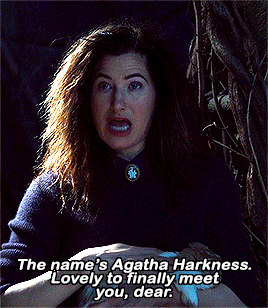
Now yes, fans of the comics knew “Agnes” was really Agatha Harkness from the casting announcement, but the actual reveal wasn’t epic because we already knew, it was epic because of the way it was revealed.
“Agatha All Along” has honestly become one of my new favourite songs, it is such a catchy tune, incorporates a couple of classic sitcom nods and is very memorable.

But also, even the fact that the final line of “…and I killed Sparky too” has become so memeable without overshadowing the overall song is such an impressive feat.
The Lopez’s not only capitalise on their Frozen success but also Kathryn Hahn gets to show her musical talents by singing the actual song…it was just incredible.
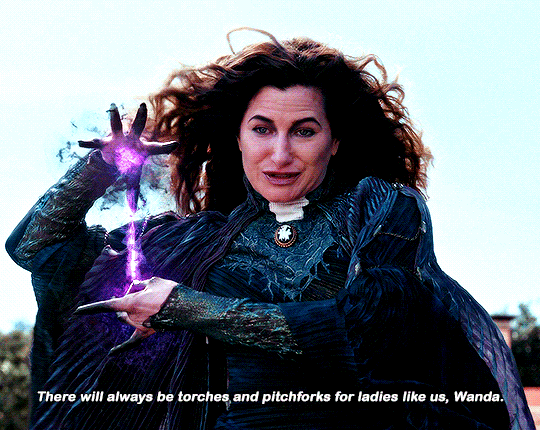
But yes, Agatha being a villain, as she has been in the comics but not on this scale, was a great decision for this series because Kathryn Hahn managed to inject her own brand of cynical dry comedy with echoes of Cate Blanchett’s Hela to create a fully rounded menacing villainous character.

Not only do we learn about her origins of how she can absorb magic by murdering her entire coven, mother included, but also that she elevates that by being able to steal any magic, even that of the powerful Scarlet Witch, truly makes this witch a threat within the magical realms of the MCU.
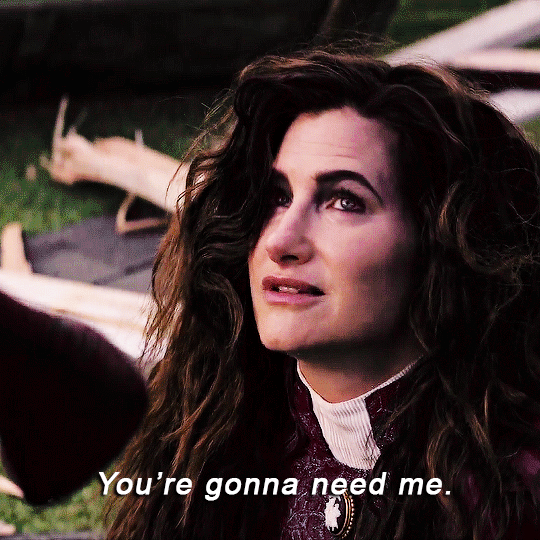
Even though she was defeated I am thrilled she didn’t die, she has simply been taken off the board for now but is still able to be put into play if and when she is needed again, maybe in Doctor Strange 2 maybe sooner, who knows?
Monica Rambeau

I have to say, I do not know much about Proton from the comics and genuinely though Maria Rambeau was a bigger character than she was, but considering they killed her off-screen during this series I don’t think she actually was.
I loved how the effects of the blip are still showing their repercussions as Monica returns after being victim to the blip and is immediately thrust into a chaotic post-blip world that echoes the real-world COVID-19 crisis I imagine.
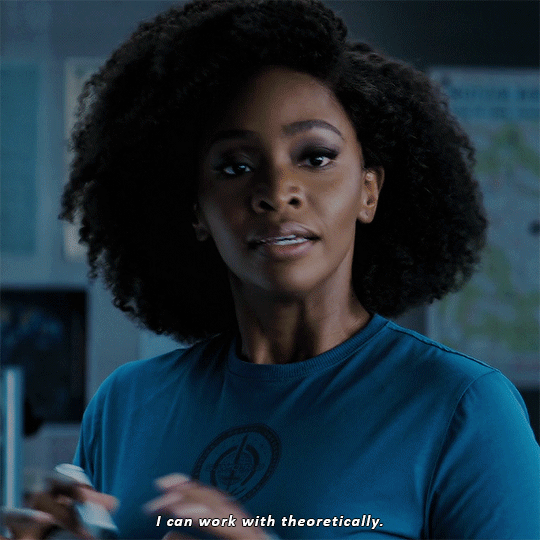
From the start once outside of the Hex, Monica hits the ground running as both a SWORD operative and a self-assured hero trying to do the right thing by saving the town of Westview and Wanda while thwarting Hayward.
I really loved how her “Boss Lady” persona that Agent Woo grants her was very well realised because she did not take any nonsense from anyone. She got the Space Rover so she could attempt to re-enter the Hex, she attempted to reason with Wanda not once, not twice, but thrice.
And when the rover couldn’t penetrate the Hex, she decided to re-enter unprotected knowing what the barrier would potentially do to her physiology…and it did not disappoint.
Monica got powers, she got powers in a spectacular way. I loved how while she was physically struggling to break through the barrier, she could hear the voices of her nearest and dearest (archive footage from Captain Marvel) which spurred her on until she finally pulled herself together and became the superpowered individual she was always going to become.
But she didn’t stop there, not only did she try to once again confront Wanda who at this point was rather unhinged, but she didn’t take her threats lying down and instead tried to break into Agnes’ house before getting caught by Fietro.
However, once she worked out Fietro was really Ralph and was able to free him from Agatha’s control, she wasted no time in running off and making herself useful and just in time as she stopped Hayward from shooting the twins and assisted them in subduing the rogue SWORD agents.

As for Monica’s future, she has been drafted by that Skrull to join Nick Fury’s new team and may return to honour her late mother’s position as director of SWORD. All I know is her future is as bright and vibrant as the energy waves she can now see.
Twins

I love Wiccan and Speed so much, I love the Young Avengers so much, I love Wiccan and Hulkling’s relationship from the comics that is inevitably going to happen hopefully, but the fact this was the origins of all of that gave me everything.

Even before their birth, I loved how the pregnancy was making everything in the house go crazy. Some fans believe this was Wanda’s powers out of control due to pregnancy, I think this was actually Billy’s reality warping powers either acting from inside the womb or amplifying Wanda’s reality warping powers.
When the twins were in existence, I feel Wanda wasn’t prepared for what was going to happen. Billy and Tommy had their own minds and weren’t afraid to show them. Not only with finding Sparky but also with revealing their powers.
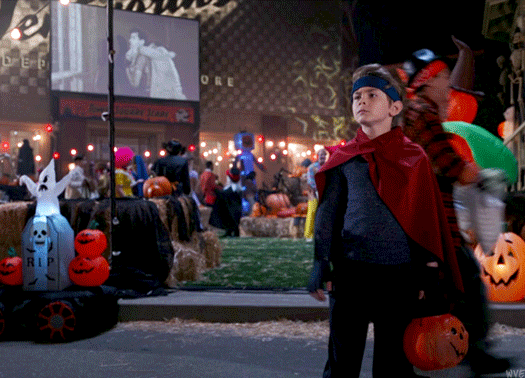
It’s fascinating as both these characters have the powers of either their mother or uncle, Billy has reality warping powers and Tommy has super speed. But while both got great chances to show them both in the Halloween episode and also in the series finale, I do believe we have only just scratched the surface of particularly Billy’s powers.

Of course they were always going to be lost at the end of the series, as they were in the comics when they were reabsorbed into Mephisto, in this instance they were seemingly deleted along with their father and the Hex…but then we hear them calling out to Wanda while she’s examining the Darkhold? Is this really them? Multiverse variants? What does all this mean? We need answers!
Darcy Lewis
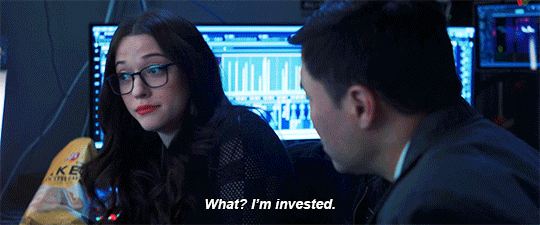
I was thrilled when I heard Kat Dennings was not only returning to the MCU but being part of different characters’ stories rather than just Thor.
I loved how Darcy was on it from the start by firstly identifying that she and the other three scientists in recruitment didn’t share any common field so that meant SWORD had no idea what they were facing, but then being the one to identify the broadcast of WandaVision.
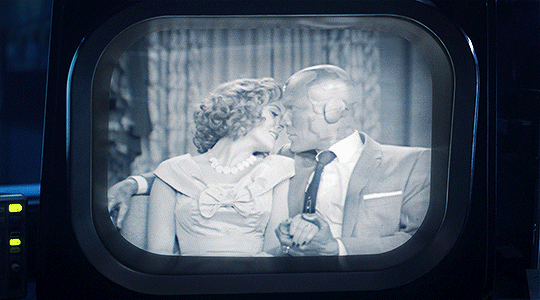
It did truly feel like we were watching Darcy be us while she was watching the series, seeing her get so invested in the hijinks and the plot twists was very relatable. Kat Dennings sold that relatability just as she does in every performance for me.
Then her fan-girling over the wider MCU, Kat Dennings is a fan of the MCU outside of her own appearances, so the fact she confirmed Vision did not get blipped but actually died and also had that moment in first meeting Monica was adorable.
Also, the fact that Darcy was the one who figured out not only that Monica’s cells were being re-written but also that Hayward had nefarious intentions with wanting to track down Vision, it just gave Darcy a purpose in the series and almost made her invaluable. Monica and Jimmy don’t have the backgrounds to be the “person in the chair” but Darcy does, and I was happy she finally got the chance to showcase it.

Even when she was taken into the Hex and temporarily became the Escape Artist, she was still Darcy in a way, then she became Vision’s source of information and road trip buddy before being left on the side-lines only to then return and help defeat Hayward.
What Didn’t Work:
Too Many Red Herrings
As I said this series and the series creatives had far too many red herrings planted to either fool us or tease us without any solid resolutions.
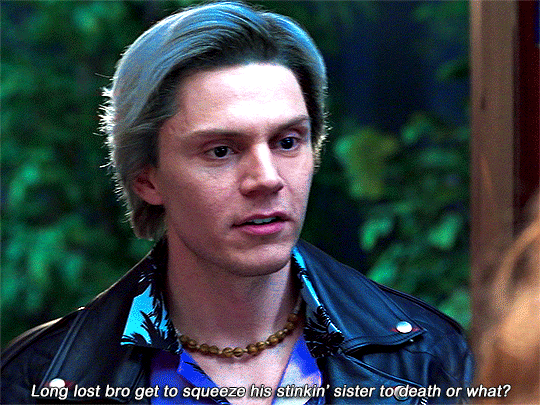
The biggest one is definitely “Fietro” who as it turns out isn’t Multiverse Quicksilver from the Fox X-Men movies but is instead an in-universe actor named Ralph Bohner who was enthralled by Agatha to play the part of her husband and be her spy and lackey.

Honestly not only am I annoyed that Evan Peters was used for what was ultimately a boner joke, but also it does throw dirt into the wound as to the fact we may not be getting Mutants or the X-Men for a while yet in the MCU.

Then there’s Dottie...similarly to Fietro this could have been a smart way to bring Mutants into the MCU. While yes Dottie was believed to be Mephisto or a witch of some description, I was actually onboard with the idea that this was the MCU Emma Frost. It would have been poetic for Agatha Harkness to be working with Emma Frost to not only maintain her manipulation but also with Emma’s telepathic abilities but also potentially have Emma working as a double agent for the Hellfire Club who also want to harness the powers of the Scarlet Witch similarly to how they wanted to control the Phoenix Force.
Wanda in the MCU has already been compared to Jean Grey, so how about Scarlet Witch becoming the Black Queen of the Inner Circle?
Next, Ultron. A namedrop as many times as this deserves some sort of payoff. Ralph got his and it may have been disappointing but at least we got resolution. So why, when Ultron was named numerous times and we as fans even had Avengers: Age of Ultron being the next recommended watch for us at the end of every episode except the finale, did nothing come of it? If White Vision was voiced by James Spader I would have been happy.
Finally, there’s Monica’s engineer “guy”. We didn’t find out who this was because the contact Monica met with was an Air Force contact delivering the Space Rover, but who was the engineer who designed it? Why didn’t we meet him?
I personally feel this engineer is Reed Richards, there is obviously a rich history of space being connected to Reed’s origins as Mister Fantastic, we know the Fantastic Four are coming to the MCU, it would simply make sense to first introduce Reed as maybe a scientist for SWORD or Nick Fury’s team before bringing in the full team.
I know the other option is Hank Pym, but really if it was Pym then why couldn’t they just pay Michael Douglas for a cameo?
The Future of the MCU
So, what does WandaVision set up for the Marvel Cinematic Universe?
Well, we know that this is the start of the Multiverse Arc that will continue with Spider-Man: No Way Home later this year and conclude with Doctor Strange in the Multiverse of Madness next year. It is confirmed that Scarlet Witch will show up in the latter of those two movies, but we have no idea what role she’ll serve in Spider-Man.
The other story this series sets up is Secret Invasion which will happen during the series of the same name starring Nick Fury and the Skrulls and also Captain Marvel 2 which will not only feature Carol Danvers and Monica Rambeau but also the upcoming Kamala Khan aka Ms. Marvel. This puts three superpowered women in the same movie and possibly will be the nexus of the Secret Invasion storyline before the concluding movie being an Avengers level event.
Then there’s also Falcon and the Winter Soldier starting in a couple of weeks, that series will most likely connect to Black Widow due to including Yelena Belova but also because that was originally supposed to come out before WandaVision it is tough to see if it or any other upcoming series except for Secret Invasion will connect to this series.
And of course, there is the upcoming Young Avengers project, we have yet to get confirmation of if this will be a movie or a TV series but we know we are having the players put onto the board in Disney+ shows and MCU movies. We have Wiccan and Speed, we know we are getting Kate Bishop and America Chavez as well as already having Cassie Lang just recast for the upcoming Ant-Man 3 to hopefully finally become Stature, and while we have yet to get confirmation of Hulkling it is possible he will appear in Secret Invasion given the Kree-Skrull elements.
Overall, I rate this series a solid 9/10, this series gave me practically everything I wanted and there were many times particularly in the finale that I felt this was the best Marvel Television series. I still stand by the fact that I think it is but the red herrings of Fietro, Mephisto, Ultron and Monica’s “guy” meant I couldn’t call it a solid 10/10.
Regardless of that, I felt this series gave us something different in an MCU mystery, formally introducing witches into the MCU, the love story of Wanda and Vision was intoxicating, meeting Wiccan and Speed in the early years was glorious and honestly Wanda embracing her destiny and becoming the Scarlet Witch…if the entire series was at that level it would be a 10/10 across the board.
So that’s my Round-Up Review of WandaVision, what did you guys think? Post your comments and check out more Marvel Reviews as well as other TV Reviews and posts.
#wandavision#marvel#mcu#scarlet witch#vision#wanda maximoff#monica rambeau#darcy lewis#wiccan#speed#young avengers#avengers#agatha harkness#fietro#pietro maximoff#quicksilver#aaron taylor johnson#ultron#evan peters#elizabeth olsen#paul bettany#kathryn hahn#kat dennings#jimmy woo#randall park#billy maximoff#tommy maximoff
14 notes
·
View notes
Text
WandaVision series review: season one with extra sake (video).
WandaVision series review: season one with extra sake (video).
The great retro TV show that was WandaVision has migrated back to reality, and as the first season fades from our memories, it’s time for the Critical Drinker to review the magic of the first Disney Plus Marvel live-action MCU TV series.
Was it a fine piece of televisual storytelling, or was it not so pucker?
WandaVision series review: with extra sake (video).
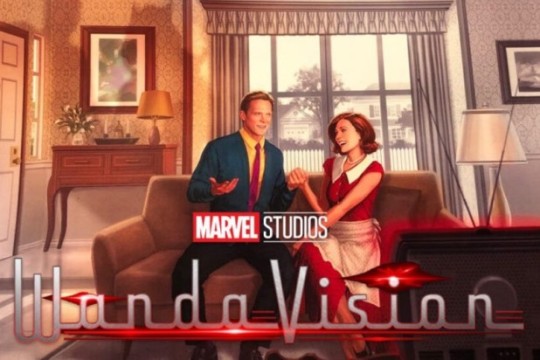
View On WordPress
1 note
·
View note
Text
WandaVision series review: season one with extra sake (video).
WandaVision series review: season one with extra sake (video).
The great retro TV show that was WandaVision has migrated back to reality, and as the first season fades from our memories, it’s time for the Critical Drinker to review the magic of the first Disney Plus Marvel live-action MCU TV series.
Was it a fine piece of televisual storytelling, or was it not so pucker?
WandaVision series review: with extra sake (video).

View On WordPress
1 note
·
View note
Text
Cultural Exegesis: Cops on Television
The following is an essay I wrote for a cultural interpretation class last semester.
Surfing the channels on television or scrolling through the selection of shows on Netflix or Hulu, it is just about impossible to miss the waves of police procedurals that saturate American media. As of the week of March 4, 2019, two television programs out of the Nielsen Top 10 list for Prime Broadcast Network TV were dramas focusing on crime and police. Even in shows that aren’t built around the police procedural genre, police feature disproportionately as on-screen characters.
Television dramas following cops are, by this point, a well-established fixture of American media. These shows have been around since the late 40s and have their roots in films about western sheriffs and private detectives. Decades of this kind of entertainment have laid the groundwork for a new set of archetypes of cop characters and made possible the rise of police-centric TV of other genres, including comedies like Brooklyn Nine-Nine and Castle.
In a 2016 interview with The Frame, researcher Kathleen Donovan, co-author of a study entitled “The Role of Entertainment Media in Perceptions of Police Use of Force,” told journalists that her findings showed that people spend more time consuming entertainment media than news, and that that affects their perceptions of the police. “By far the largest impact was on perceptions of how effective the police are,” she said. “In the content analysis, the way police are shown in these shows is that they're incredibly effective. People who watch these shows tend to think that police are a lot better at their job in terms of clearing crimes than they are in reality.” As the name of her study implies, Donovan has also found that television alters public perception of police violence. “It's almost always portrayed in a justified light,” she said. If a cop steps out of line, it is in order to punish someone the show has already proved to the audience is evil or to extract necessary information from a criminal.
While many people feel that they can distinguish between real and fictional cops, Donovan pointed out something that is troubling—“The problem is, [viewers] don't have other places that they're getting this information from,” she said. “They're not getting a lot of interaction with the police officers on a day to day level.” Even a discerning media consumer is likely to spend much more time around the cops of television than the cops of the real world. It is simply impossible to be really unaffected by this.
Of course, the idea that our media consumption habits affect our views should come as no surprise, even when the particular effect a piece of media has is disturbing. But the reason Donovan’s findings are significant is because these television programs do not spring up out of nothing. Certainly there would not be so many cop shows on TV if there was no demand for them, but that demand has its roots in something more sinister.
Matthew Alford reported for The Conversation in 2017 that since the establishment of its Entertainment Liaison Office in 1948, the Pentagon has been involved in the production of more than 1,100 television shows. And at a local level, individual police departments have worked with television producers to create positive PR consistently over the last several decades. In a letter to an ad agency in 1968, Bob Cinader, who was working on the upcoming show Adam-12, wrote, “Like all major police departments throughout the country, the LAPD's two biggest problems are recruitment and community relations. They feel that a series about the uniformed police officer would be of even greater help to them in particular and the cause of law and order in general.” In the wake of the Watts riots of 1965 and a growing sense of anti-authoritarian sentiment, turning to TV was a strategic move for the LAPD. In the time of the Rodney King riots and growing unrest, shows like Law & Order filled a similar role. Even in recent years, NYPD scandals and a resurgence of real critique of the police coincide with Brooklyn Nine-Nine and Blue Bloods.
The relationship goes beyond purely fictional television and into the realm of the late-80s boom of reality television, which turned its eye onto the police with John Langley’s COPS. “COPS’ foremost legacy, aside from its forceful introduction of a new form of televisuality, is as a highly effective PR bullhorn for the ‘human’ side of police-work,” writer Eric Harvey explains in a 2015 essay for Pitchfork. “Reenactments were replaced by what Langley called ‘raw reality,’ which encouraged a voyeuristic position to take in the action. The reality of raw reality, of course, is that COPS traded any pretense toward objectivity for an unprecedented level of backstage access; in the show’s world, perpetrators are anonymous while police officers are well-rounded characters who provide each episode’s narrative arc.”
In the 90s, whether through the sleek stories of Law & Order or the police-raid porn of COPS, television viewers were already absorbing content that would shape their understanding of law enforcement. Even if this content was not directly created by police departments or the Pentagon, in most cases, it had the approval of these authorities, and more importantly, police television going forward would be built upon the very positive image that these shows generated. A contemporary television program might never have its scripts reviewed by a government agency or work with police departments as PR, but in all things pertaining to the cops, the cultural propaganda had already worked its magic. The “good cop” archetype that shows like Adam-12 and Dragnet had worked so hard to make was already a known commodity, an established trope to build on and work with.
But more than the image of the squeaky-clean cop that captured the imaginations of many Americans, the most effective tool in changing the public perception of police has been the methodological understanding of the world that entertainment like this presents to its audiences. As Kathleen Donovan pointed out, the use of force by police is almost unilaterally justified by the narratives of the shows that depict them. “Within a minute and a half of the first episode, the show has summed up its central message: Police violence works,” Aaron Miguel Cantú writes in his 2014 review of Chicago PD. “This is relayed again and again throughout the series: When a cop with a chain-wrapped fist savagely beats a Spanish-speaking suspect demanding an attorney until he relinquishes a tip; when officers debase the idea of policing without intent to arrest; when cops round up black non-criminals and deliver them to precinct torture chambers. In every episode, these methods achieve the desired ends.” The image gritty cop programs like this present of police departments is one of a world that is, perhaps realistically, filled with violence. But in order for the police to be the heroes of this world, the plot must produce ends sufficient to justify the means: the arrest of a violent criminal, the prevention of a dangerous terrorist act, etc.
The underlying implication here is an idea that has come to be woven through much of American media: the world is a dangerous place, and authoritarian measures are a necessary evil to protect the innocent from the criminal. As the philosopher Thomas Hobbes put it, “The condition of man is a condition of war of everyone against everyone.” And certainly Hobbes would approve of this picture painted by cop shows: the rights of criminals (who are at any time determined to be so by law enforcement) are incidental to preserving order and so must be subsumed into the Leviathanic police state for the good of everyone. The television programs can do their best to portray cops as wholesome defenders of the peace. But at some point, there needs to be a little realism—the fact that these people carrying guns on behalf of the state employ violence as a part of their job is too obvious to ignore. So the TV instead presents us with police forces who do engage in violence, who do things which would be unspeakable for any real-life civilian—but they present us with the kind of world that makes this justifiable, a dangerous, threatening world in which everyone is an enemy. Donovan highlights the fact that the majority of television crimes are murders—a gross overrepresentation, but one that helps to uphold this image. This is the kind of world that justifies police violence. The narrative is not just about trusting the police, it’s about being afraid enough of everyone else to believe firmly that everything the police do is necessary.
This is the world of COPS. As Tim Stelloh writes in a 2018 article for The Marshall Project, “Civil rights activists, criminologists, and other observers have described [COPS] as a racist and classist depiction of the country, one in which crime is a relentless threat and officers are often in pitched battle against the poor black and brown perpetrators of that crime.” It’s a fascist’s view of society, coming here not from writers but from the police themselves, whose commentary frames the events of each episode. COPS gives viewers a taste of the reality of American law enforcement, just not the reality it claims. The program allows us to see the role of police as they see themselves, in full, action-packed detail.
The other side of this authoritarian outlook has become a media obsession in recent years, perhaps nearly to the extent of police procedurals. The appeal of shows like NBC’s Dateline in presenting the shock and horror of crime has proven effective even with a more dramatic format. Where Law & Order walked the line between the heroism of the justice system and the horror of crime, programs like Criminal Minds tend to delve deeper into the latter. This kind of media, lending its attention to serial killers and brutal rapists, provides a necessary balance for the traditional cop dramas. Hannibal, American Crime Story, and adjacent programs give us criminals who are as intelligent and charismatic as they are violent—worthy opponents for an increasingly militarized and surveilling police force. Of course, one might argue that these characters are clear fantasies to audiences, like supervillains or space aliens. But if most viewers have little interaction with police, how much experience can they be expected to have with killers? The intellectually or socially capable murderer provides the kind of fear necessary to move people towards embracing the total authority of law enforcement—both on-screen and in real life.
This fear is more congruent with later cop shows whose focus on gritty violence in the name of justice measures up to the violence of depraved criminals that fascinates audiences. But the friendlier image of police from the days of Adam-12 still finds its place in modern television. One niche is in the aforementioned police comedy—shows such as NBC’s Brooklyn Nine-Nine give us police to relate to and enjoy who are earnest in their pursuit of justice and can accomplish their (admittedly tamer) goals with minimal violence and maximal shenanigans. In a time of pubic distrust for the police, B99 excuses its cops from blame by contrasting them to bad cops and making gestures toward the notion that police violence is an issue of concern. But a show that concerns itself mainly with police as a wholesome source of comedy is ill-equipped to deal with the uncomfortable realities of the NYPD’s behavior. How often is Andy Samberg’s good-hearted character called upon to evict homeless people from parks or cooperate with ICE officers to detain migrant families? Citing the NYPD’s record-low public opinion ratings, Will Leitch writes in a review for Bloomberg, “This hasn’t reached the world of Brooklyn Nine-Nine. The only people who hate cops on Brooklyn Nine-Nine are the wretched perps our heroes keep hauling in. The sitcom is standard cop-show fare in that regard, except more so; while a drama can allow our cop heroes the shading to become anti-heroes, the sitcom can’t really go that dark.”
Alongside the police sitcom is another niche for friendly cops to make an appearance which is perhaps more troubling: in children’s media. A slew of op-eds by parents in 2017 in publications like the Guardian and Baptist News called into question some of the implications of television shows like Paw Patrol. The cartoon, featuring dogs in the roles of emergency services, shows its police pup Chase using a “spy drone” for surveillance and coming to the aid of helpless citizens who continually put themselves in danger. Many parents were concerned about the lack of nuance in how the show presented authorities. In a response to these concerns Elissa Strauss wrote for CNN’s website, she cited author Tovah Klein, explaining, “Despite their reputation of innocence, children are bubbling cauldrons of conflicting feelings and impulses. This is especially the case during toddler and preschool years, when they become aware of their capacity to do bad things and struggle with understanding those urges. […] Good and bad are clearly articulated states in those shows, and should one misbehave, the repercussions are clear and predictable.” Strauss seems to believe this is sufficient to let parents breathe a sigh of relief. But if the response to children’s struggle with right and wrong that Paw Patrol gives is to seek the approval of authorities, what is there to be relieved about?
The amiable, endearing police of Paw Patrol and Brooklyn Nine-Nine who are eager to help and the tough, violent cops of Chicago PD and COPS who are a necessary force against the horrors of crime represent a particular understanding of law enforcement that is transmitted to children and adults alike. When the primary experience of most people with police is in entertainment, the images stick, and its effects make themselves known. In public discourse, people can be tricked into defending the actions of real police officers based on their time spent with the stories of fictional cops. Despite claims of a national crime wave and a “war on police,” the Brennan Center reports, as of 2017, declining crime rates and assaults on law enforcement, while Mapping Police Violence reported a general increase in the number of people killed by police from 2013 to 2016. While it may just be the tip of the iceberg of a culture of authoritarianism, cop shows on TV are at least partially responsible.
63 notes
·
View notes
Text

Farewell GAME OF THRONES.
Thank you for all this years of adventures, magic, broken hearts, depression, and wonder.
Thank you for proving that audience could love complex and high quality show, improving the televisual art forever.
Thank you for all this past years of inspiration and all the ones to come.
It was a extraordinary ride.
🐉🐺🐟🦌
•
•
#gameofthrones #goodbyegameofthrones #daenerystargaryen #emiliaclarke #jonsnow #kitharington #aryastark #maisiewilliams #sansastark #sophieturner #peterdinklage #tyrionlannister #jasonmomoa #fanart #art #artist #artwork #drawing #dessin #illustration #portrait
#game of thrones#daenerys targaryen#jon snow#arya stark#sansa stark#tyrion lannister#fanart#jason momoa#emilia clarke#maisie williams#sophie turner#kit harington#peter dinklage#art#artist#drawing#dessin#artiste#illustration#artwork#portrait#tvshows
17 notes
·
View notes
Note
Of the two, which one had worse production values? The Sonic cartoons or the Mario cartoons?
I really don’t know to be honest, it’s not as clear cut as one might think. Sonic the Hedgehog (SatAM) certainly had the advantage of being a network television production, therefore netting that nice ABC television money (though I would say the animation wasn’t that much better than most shows at the time, certainly not on par with Disney or Warner Bros. televisual cartoons). However you also have to contend the fact that The Super Mario Brothers Super Show had live action actors, and not exactly nobodies either: Lou Albano (RIP), Roddy Piper (RIP), Danny Wells (RIP), Magic Johnson (still alive), Ernie Hudson and SHABBA DOO aren’t exactly cheap. True, most of the guests on the live-action segments were D or even E-listers but it still must have cost DiC some dinero to make, though considering how lousy the animation was in that show maybe that’s where the money went.
As for the other two Mario cartoons, both have much better animation than Super Show, but it’s still below SatAM, The Adventures of Super Mario Brothers 3 is roughly on the same level as AoStH if you discount the TMS animated episodes, though I would say that even the non-TMS episodes slightly edge out the Mario show, but that might just be my bias. Super Mario World is also hovering around SatAM in terms of it’s animation quality. Take all that with a pinch of salt however, as I don’t really think SatAM has much better animation than AoStH; the only real difference in my opinion being the fact that SatAM has shading and more detailed backgrounds.
As for Sonic Underground (I’m not going to bother with the non-DiC cartoons, that includes Mario’s OVA and the Saturday Supercade), that is using digital animation so it’s perhaps not really fair to compare it to them. Sure a lot of the animation is a hot mess in that show but at least the character movements are smooth and it’s still better than Super Show.
So to answer your question, probably Sonic, I don’t really know enough about the Mario show’s production to comment, but I do know that SEGA did oversee both SatAM and AoStH’s production. Including ‘men from Japan’ according to the ‘Executive In Charge Of Production: Sega Of America’, Michealene Cristini Risley. So let the fact that some guys from SEGA oversaw the making of AoStH and SatAM and said ‘yes, this is all well and good’ (which is superb because we all got some great laughs and SatAM).
20 notes
·
View notes
Text
Slasher Season 1: The Executioner (2016)
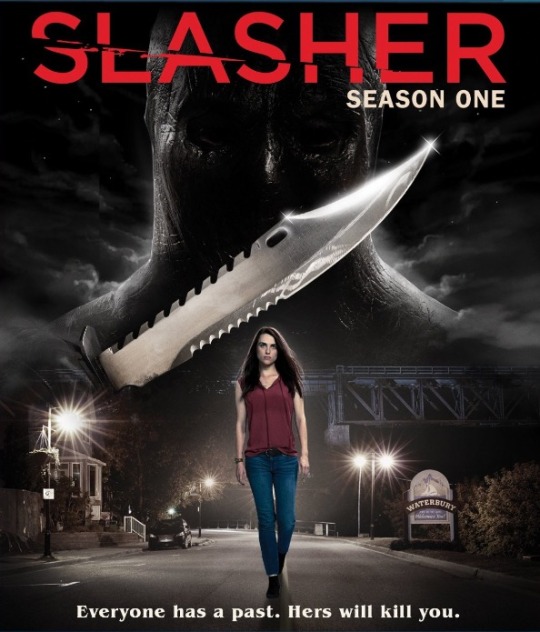
Directed by Craig David Wallace
Written by Aaron Martin
Music by Shawn Pierce
Country: Canada
Language: English
8 Episodes of around 46 – 53 minutes each
CAST
Katie McGrath as Sarah Bennett
Brandon Jay McLaren as Dylan Bennett
Steve Byers as Cam Henry
Patrick Garrow as Tom Winston
Dean McDermott as Iain Vaughn
Christopher Jacot as Robin Turner
Wendy Crewson as Brenda Merrit
Jessica Sipos as June Henry
Mary Walsh as Verna McBride
Enuka Okuma as Lisa Ann Follows
Erin Karpluk as Heather Peterson
Mayko Nguyen as Alison Sutherland
Rob Stewart as Alan Henry
Jefferson Brown as Trent McBride
Mark Ghanimé as Justin Faysal
Dylan Taylor as Bryan Ingram
Alysa King as Rachel Ingram
Victoria Snow as Sonja Edwards
Hannah Endicott-Douglas as Ariel Peterson
Shawn Ahmed as Sharma
Booth Savage as Ronald Edwards
Susannah Hoffman as Marjorie Travers
(Guilty Party: I took the images from IMDB because I can’t screengrab over 8 hours and besides, my dog told me to.)

Slasher: The Executioner is a Canadian TV series about, um, slashers and all that slasher stuff. Bogling about The Internet I discovered that the creator, one Aaron Martin by name, has wisely opted for an anthology format, whereby each season (two at present) is a complete storyline. Apparently there is connective tissue between each season to engender a feel of them taking place in the same Slasher Universe; which is like the Marvel®©™ Universe but with less quips and more mom porn and severed hands. I say “apparently” because I haven’t seen the second season (Slasher: Guilty Party (2017)) I have seen the first season though and that definitely has more mom porn and severed hands than the Marvel®©™ Cinematic Universe.

Now, if you’re reading this thing which is about a TV show called Slasher, then you might think you like slasher movies, but do you like slasher movies enough to watch what is effectively a 7 hour and change slasher movie? Do you? Huh? Huh? That’s a normal working day right there. You are right to be hesitant, as that doesn’t sound like it would work, at least not as entertainment, maybe as a kind of torture. The usual slasher movie is a timidly formulaic creature, so we can characterise the average slasher movie as starting with a brief kill, then some flopping bonelessly about with a solid hour of “meet the characters”, then 40 minutes or so of mayhem, climaxing with a one on one slobberknocker. Stick to that formula for 8 episodes and you’d end up (NB: the maths is a bit loose here) with an exciting first episode, 5.5 episodes of dishwater dull soap-operatics and then an insanely violent final 1.5 episodes. That would of course be stupid, which is one of roughly a billion reasons why they didn’t ask me to make it. No, they asked Aaron Martin and the Slasher gods should be thankful that Aaron Martin knew what to do.

A nagging sense of fairness demands I should pause to note that hundreds of people were involved in the making of Slasher: The Executioner, but it’s accepted shorthand to say “Aaron Martin…” So, “Aaron Martin” made a long-ass slasher movie, but realising this was a marathon and not a sprint, structured each episode so that it worked within the larger narrative framework. It’s an approach familiar to anyone who read mainstream comics back when they had actual stories (rather than today’s unending conversations punctuated by punching; Calm down, Cochise, I’m not saying they were better back then (most of anything is shit after all), I’m just saying they were different). In effect then, for all the none old timey comics fans: in Slasher: The Executioner the uberplot chugs along while various subplots intertwine beneath it breeding red herrings, developing character and basically raising the stakes until uber and under finally intertwine in a climactic crescendo. Oh, and there is at least one kill every episode to keep your unhealthy interest piqued. Got to have those sweet, sweet kills. It is called Slasher after all, not Magic Picnic Time With The Dancing Rainbow Babies. Those dismissive of the slasher movie (Hi, mom!) often underestimate the variety of slasher movies; they aren’t all set in a holiday camp for randy morons on Prom Night one Halloween which is coincidentally, and impossibly, also Friday the 13th. No, there is also Cherry Falls (2000) and, oh, My Bloody Valentine (2009) and, er, anyway, probably some others. This type being The Small Town Terrorised by Its Past slasher, as it is more commonly known. This is the template which Slasher: The Executioner favours most. (The Internet Elves tell me Slasher: Guilty Party riffs on The Holiday Death Camp template).
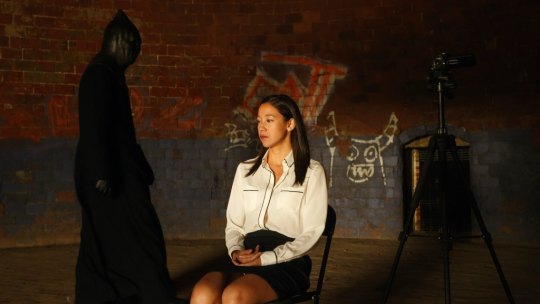
Events kick off with the present day return of pleasant, newlywed young artist Sarah Bennett (née Ingram) to Waterbury, where she was born on Halloween night in 1988, when a masked killer cut her from the womb of her mother, Rachel. Rachel’s husband, Bryan, had died about ten seconds earlier from a frenzied knife-torso interaction, leaving nobody to hand out candy to the trick or treaters except the killer, The Executioner, who docilely awaited the police cradling the bloody new-born in his arms. It’s fair to say Sarah has issues with Waterbury, and as her arrival coincides with the start of a spate of copycat Executioner killings, Waterbury has issues with Sarah. And it’s this business that occupies your eyes and ears for the bulk of the 8 episodes. I mean, that was some spoilertastic stuff back there, yeah? But get this…that was only the opening 10 minutes; there’s plenty of unspoiled stuff and, hey, maybe those first 10 minutes I just got spoil all over aren’t all as they initially appear? That is a distinct possibility. Yes it is.

What then unfolds over the televisually paced course of Slasher: The Executioner’s 8 episodes is slashtastically fun stuff. Pretty much everything you expect in a slasher movie happens, because that predictability is part of the fun of a slasher movie. Crucially, however, some stuff you don’t expect to happen in a slasher movie also happens, which is part of the fun of a good slasher movie. A good slasher movie has to both cater to and exceed expectations, and Slasher: the Executioner is a pretty good slasher movie despite its arse-numbing running time. But then only a glutton would gulp it down one go; Slasher: The Executioner is most rewarding when taken episodically; which is kind of why they made it like that, I guess. With a gap between each episode you can ruminate and ratiocinate in an attempt to understand the motivations, unearth the clues and unmask the killer. Although, good luck with that; the identity of the killer may be easy to guess (it’s [Redacted]!) but it’s a lot less easy to back it up with clues and evidence. It’s more a case of “It’s [Redacted]” because it has to be, rather than you have been perceptive enough to amass an evidence trail suitable for a Court of Law. But then slasher maniacs rarely see the inside of a Court of Law, so going with your gut is okay in this context.
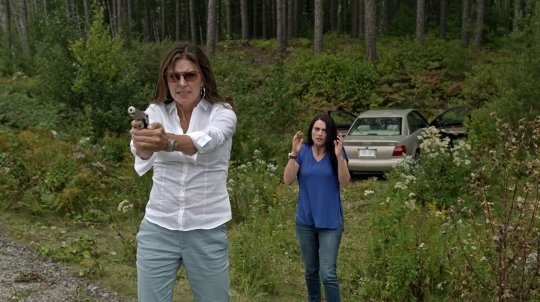
The cast though? I mean, you’re going to be spending a lot of time with these people and given the nature of the beast some of them are going to have to surprise you with who they really turn out to be. Happily, everyone in Slasher: The Executioner is far better at this acting lark than the usual cast of a slasher movie. It probably helps that unlike most slasher movies the cast is portraying adults rather than the more usual teenagers. Feeelingzzzz aside, adult life is a lot more complex than teenage life, so there’s a lot more scope for surprise behaviour wise. And adults by definition have lived longer than teenagers so they have an actual past which could, maybe, be full of misdeeds and tragedy. That kind of thing would be pretty helpful were you trying to fill about 8 hours of screentime, yeah? Yeah, it totally would. As Sarah, Katie McGrath is maybe a bit of a milksop but this, to be fair, pays off later with a major change in attitude, and also in her defence she is mostly on the backfoot as surprises and violence tend to single her out. And she certainly rallies herself with an impressively sad ferocity come the bloody climax. Brandon Jay McLaren as her life partner convinces as a man too nice to be true, but who just might come through. The killer is great and clearly having a fun time, but their performance becomes a real humdinger once the reveal hits and the pretence can be dropped (in front of the viewer at least). Lots of actors, lots of performances and all of them are lots of fun. Some are more fun than others, but saying more would splash spoil all over the place. In a town this big there might be more than one mystery, is all i’m saying.
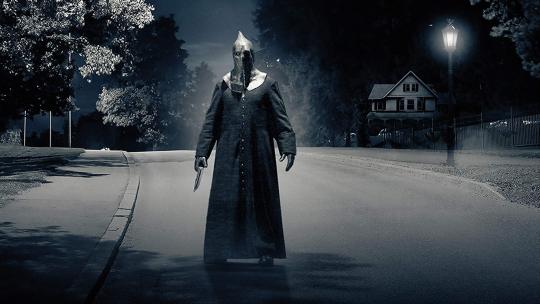
Slasher: The Executioner is overwrought, it’s daft, it’s violent, it’s rarely dull and it successfully stretches your suspension of disbelief like so much Silly Putty. Pretty much a dreamy slasher experience all in all. Of course many a long form TV show comes a cropper when it has to deliver a definite ending. But rest easy, the end of Slasher: The Executioner doesn’t reveal everyone is dead, and, no, it wasn’t all a dream. The stakes are high ending wise; after nearly 8 hours Slasher needed to deliver a faceslap of an ending, and while the mechanics of what happen are hardly brain meltingly original, the psychological darkness of it was a bleak delight. In short the ending to Slasher: The Executioner is a TV win: it doesn’t make you wish you hadn’t bothered. As long as you came expecting a slasher, that is. The clue’s in the title after all.
#slasher#slasher: the executioner#tv#canada#horror#2016#aaron martin#katie mcgrath#brandon jay mcclaren#2010s
28 notes
·
View notes
Text
Eddy Bosnar's bullet vs Togel Hongkong Kyoto Sanga
Australian defender Eddy Bosnar continues to impress with his whole-hearted displays at the centre of the Shimizu S-Pulse defence, with the lanky Australian one of the star signings of the new J. League season.
Bosnar has also earned plenty of plaudits for his thunderous free-kicks, and many are now calling for Socceroos coach Pim Verbeek to call up the tall stopper for Australia's World Cup campaign in South Africa.
With dead-ball delivery like this, Bosnar may just be a bolter for selection in Australia's preliminary 27-man squad.
Political footballs
The English football season reaches its climax in the same Togel Hongkong week as the British General Election campaign reaches the finish line.
Like the annual Premier League toss-up between Chelsea and Manchester United, the General Election is usually a straight fight between the reds and blues, but this year the election has seen an orange team appear from nowhere in the form of a congenial and assured televisual image named Nick Clegg.
There is no orange interloper in football however, where Hull City fell out the Premier League and Wolves struggled, although Blackpool may yet make it to the promised land via the play-offs.
Football and politics have generally taken different roads in Britain, perhaps as a testament to the social delineation of the working class in industrial regions from the ruling class in the Westminster village. But the sport's booming popularity in recent years has dragged the suits into the grounds, or at least forced them to pay lip service to the people's game from the lofty perch of the executive box.
Although overseas leaders had been doing it for years, such as when Benito Mussolini shamelessly hijacked the 1934 World Cup, it was Huddersfield FC man Harold Wilson who first twigged that football's popularity could rub off onto British politicians, when England won the World Cup during his Premiership. As comic creation Alf Garnett quipped, it must have been Wilson who made England wear Labour red for the final.
Wilson's populist move backfired when he closely identified himself with England's 1970 squad, whose painful elimination's proximity to the election cost him his job, he later claimed.
The Prime Minister had himself photographed with the team in front of No. 10, Downing Street, setting a precedent repeated every four years since. In the 1980s, a PM virulently hostile to football held sway but even the Iron Lady found her swinging handbag unable to put soccer in its place and she grudgingly went ahead with some winsome photoshoots with Emlyn Hughes, Kevin Keegan et al.
Margaret Thatcher saw no connection between her economic policies and the growth of spectator violence, and was taken aback when FA Secretary Ted Croker told her pointedly, "Not our hooligans, Prime Minister, but yours. The products of your society." Her magic wand was an ill-conceived plan to force fans to carry an I.D. card, which would be withdrawn from the miscreants.
It was an unnecessary endeavour, which would have failed to stop fights outside grounds and was obviated anyway by the arrival of CCTV inside them, but was enthusiastically trumpeted for too long by the shrill Colin Moynihan, aka The Miniature for Sport, until the Hillsborough tragedy sank the soccer ID ship for good.
The Thatcher years did foment some form of politicisation among fans and legacies of her general disconnection from the industrial regions who breathed football strongest included the Football Supporters Association, the start of supporter involvement in clubs and a burgeoning fanzine culture rejecting the official face of the game and the authorities.
The grassroots were very green in the late 1980s as Thatcher's reign tottered towards its inevitable end, but football remained very much a minority interest in Britain as a whole. The fences, the strict policing, the labeling of fans as hooligans by the largely right-wing media had created a siege mentality among die-hards constantly challenging the public consensus that football belonged in the gutter. The enlightenment of Italia '90 and the seismic year zero of Sky TV's Premier League in 1993 lay in an unimagined future.
Thatcher's successor John Major was Satta King less abrasive than his predecessor towards everything, and immediately said he was a Chelsea fan, making sure he was filmed attending games with fellow Tory David Mellor MP, although interestingly his sporting interests were listed as 'cricket and rugby' before he became PM.
Pavarotti, Gazza and all had brought a spring-cleaning no-one had expected, but the after-effects in England of that summer in Italy were too powerful and popular to ignore at the highest level again. Engaging with England's football culture was now de rigueur for its top politicians.
Tony Blair joined the club, claiming he was a Newcastle fan (his constituency was in the North-East), kicking around with Alex Ferguson and Kevin Keegan and rushing to tell the nation he was one of us when England were knocked out the World Cup.
Gordon Brown has wasted little time kicking a ball for the cameras to launch England's 2018 World Cup bid, and the Scot who lost an eye at rugby made sure the film crew was there to see him grinning at the Three Lions winning at football on telly.
Well-to-do Londoner and Old Etonian David Cameron has been at pains to paint himself as a footy man. He claims to support Aston Villa (his uncle used to be chairman), attached a St. George's cross to his bicycle in 2006 and invited himself to David Beckham's pre-World Cup party when he was not on the guest list. Never again will a British party leader shun the nation's number one sport you can be sure, but how refreshing it would be if they did, expressing a preference for a less-mainstream game or pastime instead of pandering to the PR protocols.
While leaders are desperate to appear as fans, even to the extent of humiliating themselves, the players are generally much less keen on politics, preferring to enjoy their lifestyles without concern for the bigger picture, although their stratospheric wages militate towards right-wing votes. Even in the 1960s, Hunter Davies was surprised when writing 'The Glory Game' that none of the Tottenham players he got to know were Labour supporters at a time when the majority of the nation was left-leaning.
An exception to the apolitical player was Scotland international Pat Nevin, who campaigned openly for Labour and made a point of travelling to Chelsea games by tube to dispel the image of overpaid stars voting for whoever would hand them the lowest taxes.
Frank Lampard, who has been a vocal supporter of the Conservative Party, stands out as a politically-aware footballer today, while Sir Alex Ferguson continues to fly the flag for Labour. But they are still voices in the wilderness.
Everyone ought to care about politics, whatever their status. And the nation cares about football sufficiently in terms of hours and money to make the election relevant to fans. Gary Lineker said he would not reveal his voting intention for fear of alienating some of his fans, and perhaps that is the wisest counsel, but should not stars of any description consider using their clout to campaign on an issue that matters, even if not on a Jamie Oliver scale?
So is this election relevant to football fans? Labour's proposal to let fans own 25% of clubs is at least worth debating. With on average four clubs a year in Britain going into administration over the past decade, and clubs run in such a cavalier fashion it makes investment banks look prudent, how the game is regulated by government does matter - just ask Crystal Palace or Portsmouth supporters this season. With Michel Platini's calls for English clubs to sort themselves out or face sanction growing louder all the time, the fields of politics and football are far from mutually exclusive.
But the reality is football will be low to non-existent in people's minds as they enter the polling stations on Thursday. Most players don't really care who wins any more than the politicians care who wins the Premier League this weekend, but you can bet the latter will still be screaming they are one of us once the World Cup kicks off in June. As long as football enthralls millions, politics will be looking to jump on the bandwagon.
0 notes